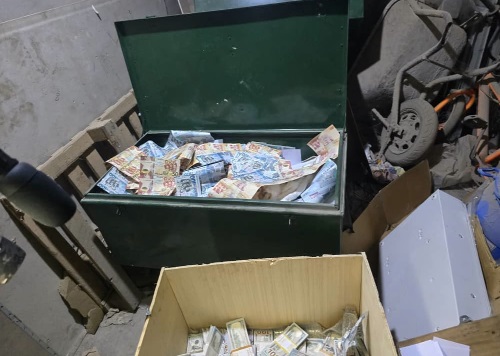A high-level investigation has been launched after National Security operatives discovered genuine Bank of Ghana (BoG) money boxes at the hideout of a notorious counterfeiting syndicate in Sapeiman, near Accra.
The boxes, marked “EXCLUSIVE to the Bank of Ghana”, were not imitations but verified authentic containers used by the central bank—raising serious questions about how state-secured property ended up in criminal hands.
The syndicate, which was busted in February 2025, had been operating under the guise of a modest vehicle battery shop dubbed “Battery Doctor.” But behind its shabby exterior lay a sprawling counterfeiting ring housing 10 40-foot containers filled with fake U.S. dollars, Ghana cedis, and even counterfeit gold bars.
According to the Director of Special Operations at the National Security Secretariat, Richard Jakpa, the syndicate’s activities extended to areas such as East Legon and Dzorwulu, where further arrests and seizures—amounting to over $100 million in fake currencies—were made.
The discovery of authentic BoG cash boxes among the items has heightened national concern. Mr. Jakpa said authorities are treating it as a breach of institutional integrity and are determined to trace how such secured items were diverted.
“This isn’t just about fake money,” Jakpa told journalists during an exclusive tour of the scene. “It’s about protecting the credibility of Ghana’s financial system. The fact that these were original BoG containers makes this a matter of urgent national importance.”
Read Also: Gov’t to deport foreign galamsey operators as military crackdown looms
The alleged ringleader, known only as “Alhaji,” remains at large. He is believed to have fled shortly before the raid, potentially moving two containers before the bust. National Security says it is actively tracking him and will leave no stone unturned in bringing him to justice.
The operation also uncovered a complex human surveillance system, with a lotto kiosk serving as a watch post to alert the gang of any approaching outsiders.
The crime scene itself—a small, unfinished two-room structure—was a cover for a high-level operation using near-perfect counterfeit notes that could only be identified under UV light.
Authorities have since secured the site and all evidence for ongoing investigations. Meanwhile, security experts are calling for a comprehensive audit of internal systems at state institutions to prevent such breaches in the future.


























